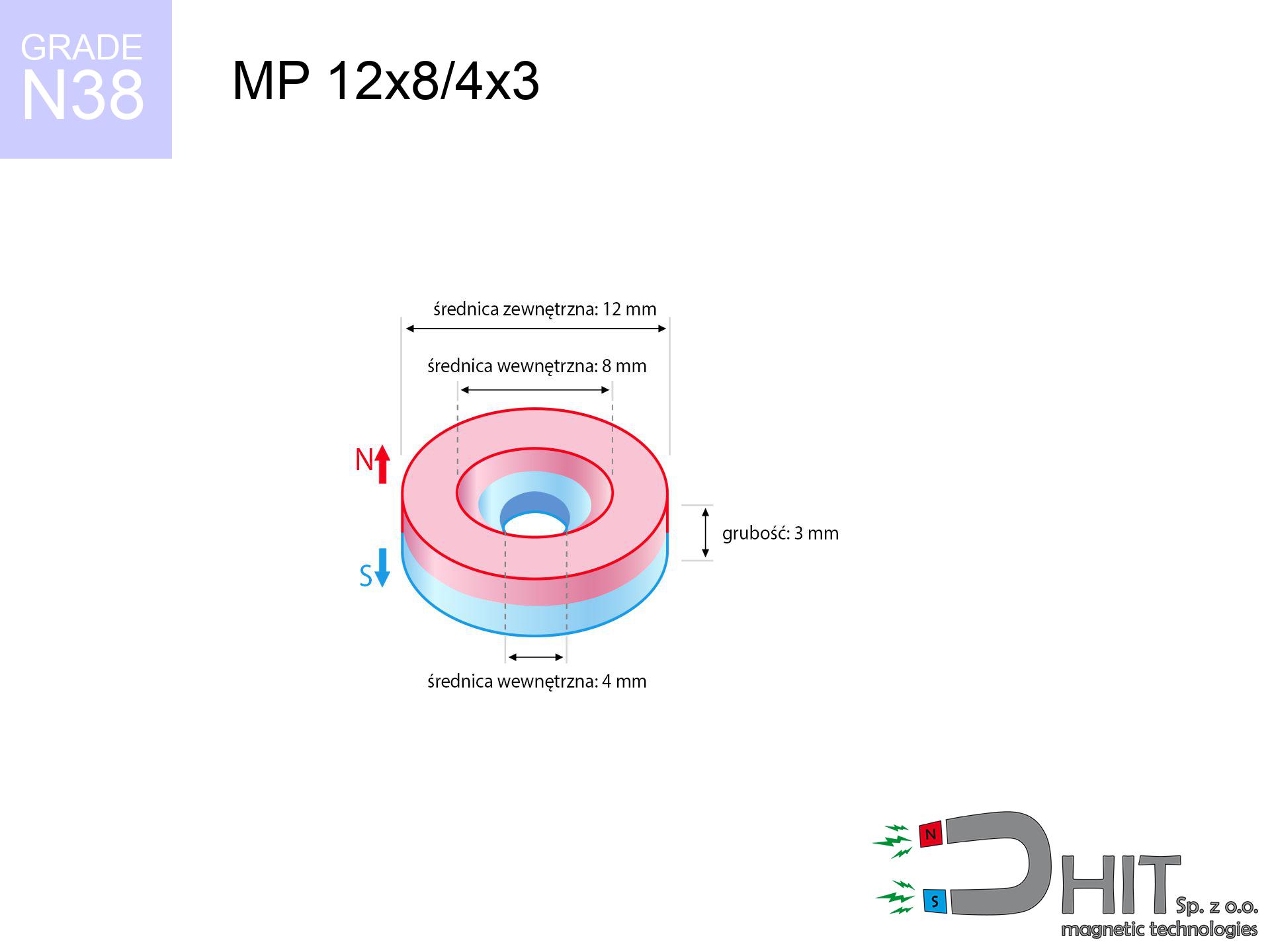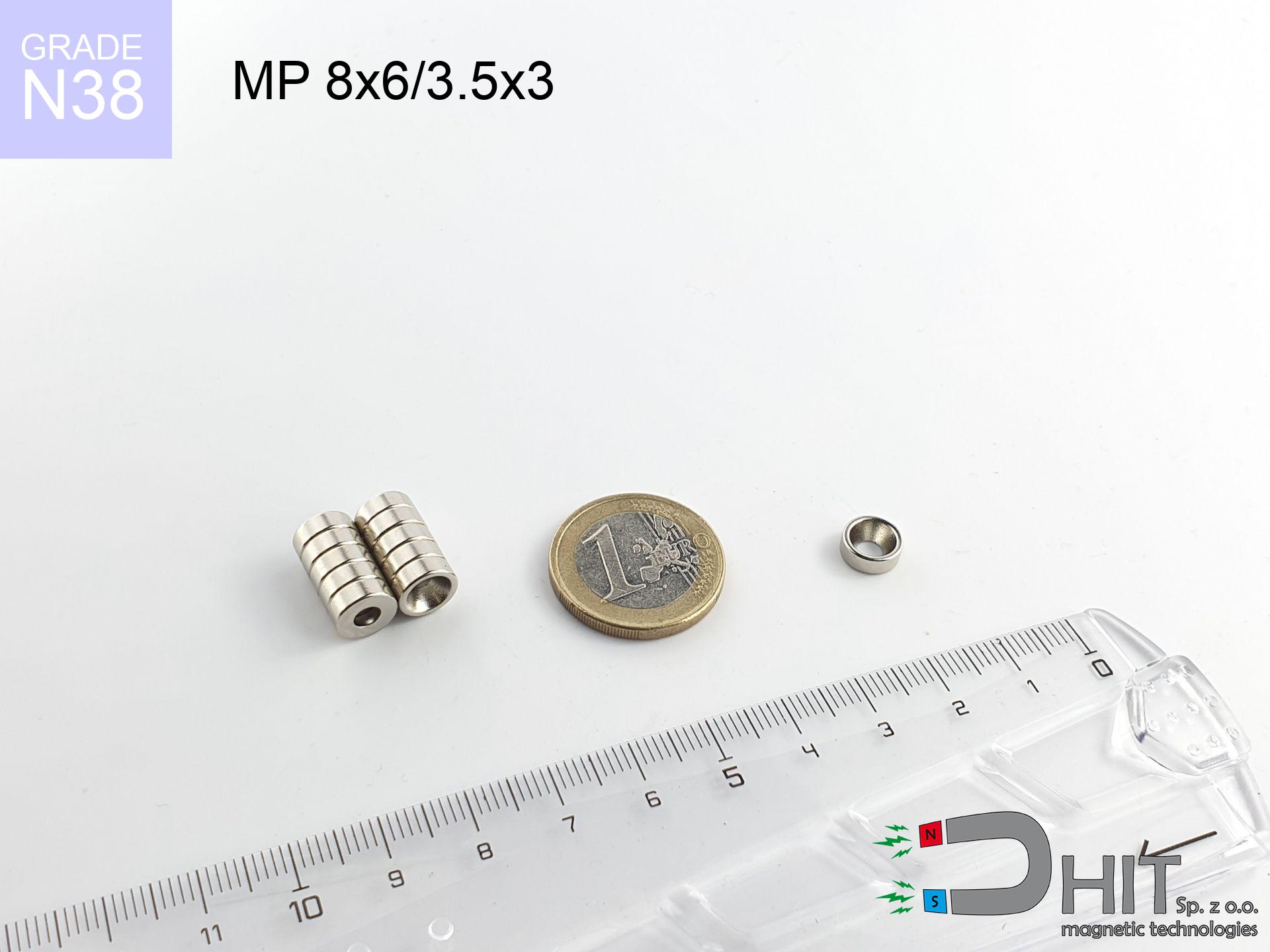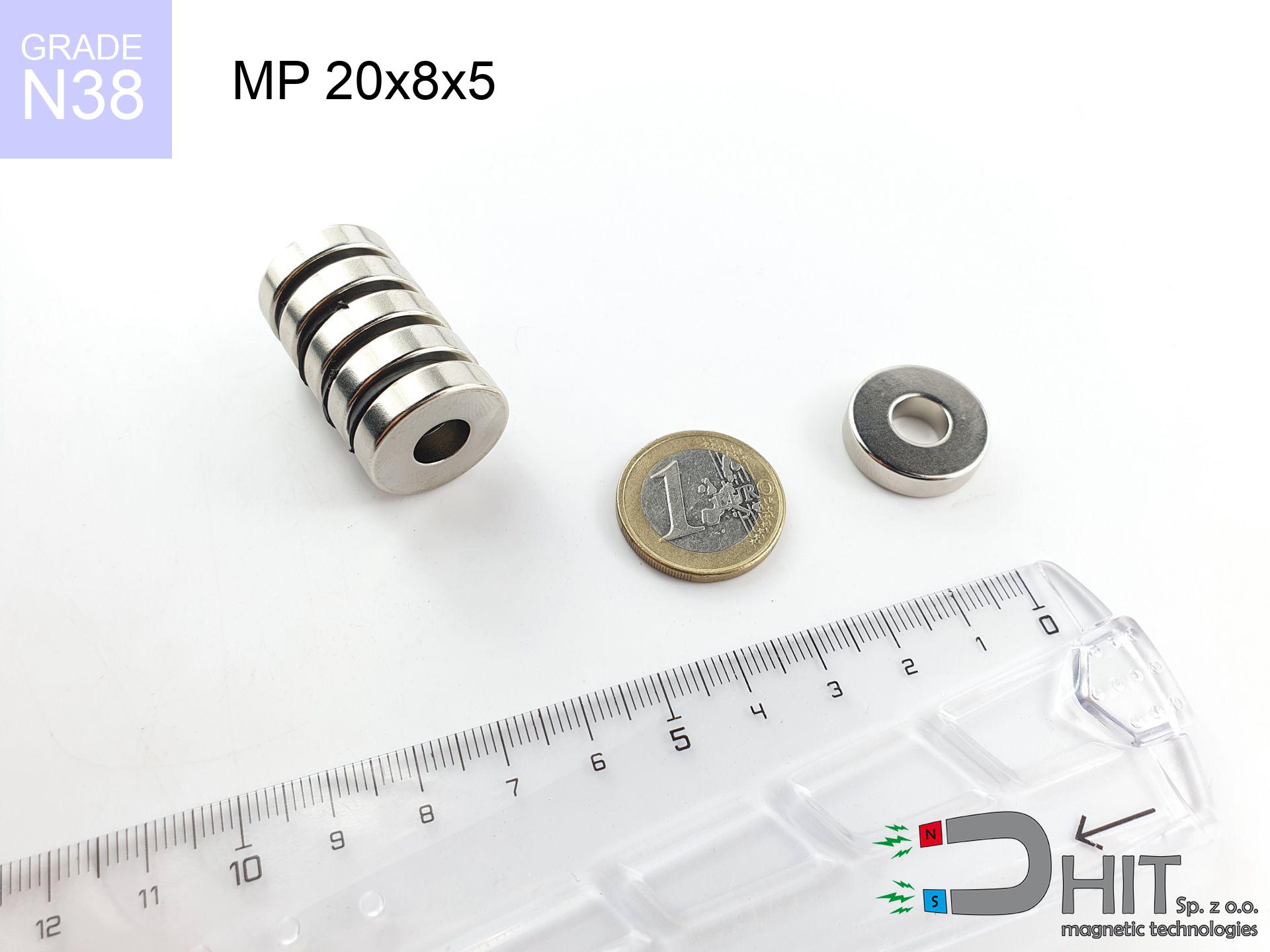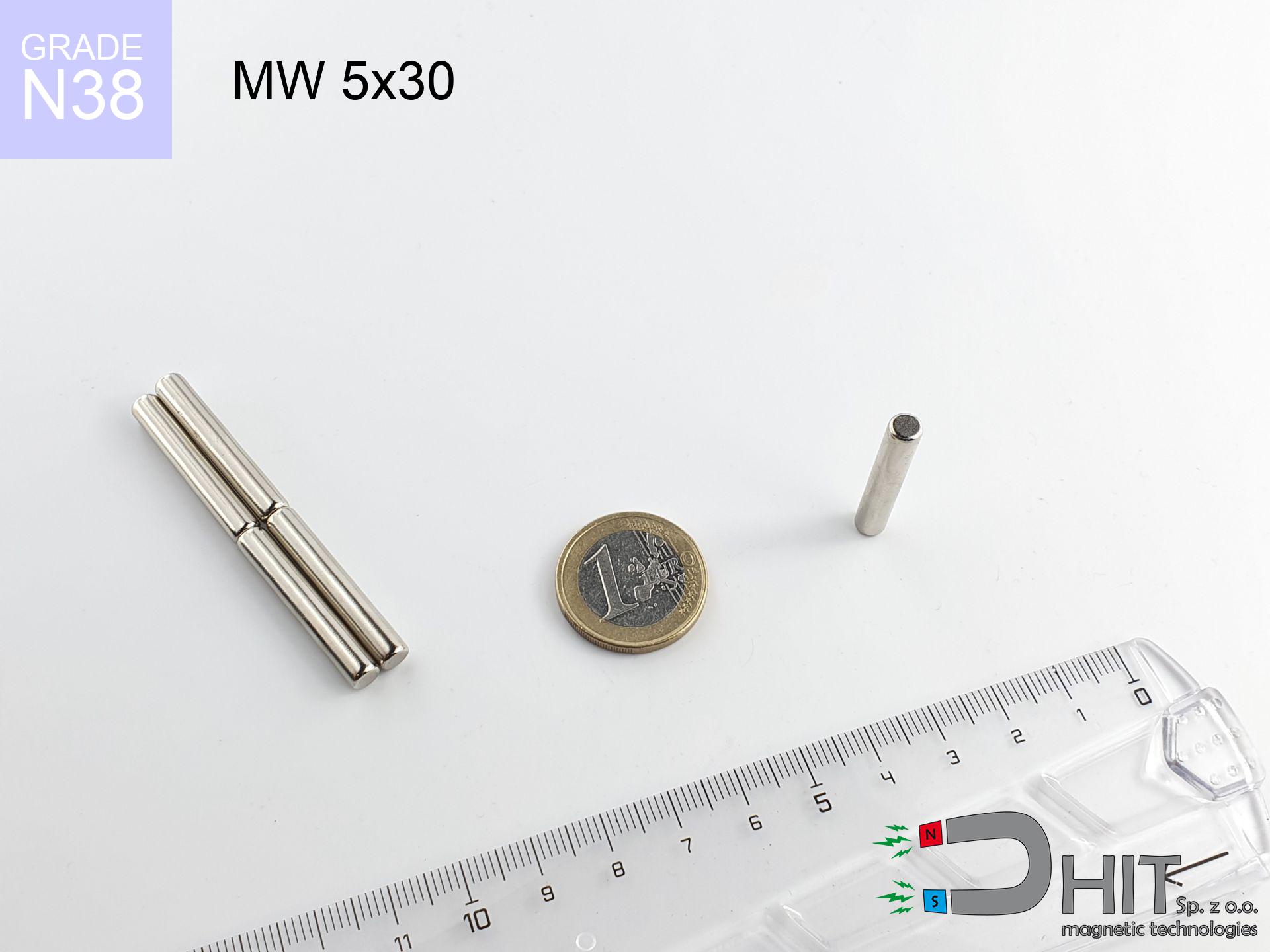MP 12x8/4x3 / N38 - ring magnet
ring magnet
Catalog no 030395
GTIN/EAN: 5906301812326
Diameter
12 mm [±0,1 mm]
internal diameter Ø
8/4 mm [±0,1 mm]
Height
3 mm [±0,1 mm]
Weight
2.26 g
Magnetization Direction
↑ axial
Load capacity
2.21 kg / 21.72 N
Magnetic Induction
277.09 mT / 2771 Gs
Coating
[NiCuNi] Nickel
1.427 ZŁ with VAT / pcs + price for transport
1.160 ZŁ net + 23% VAT / pcs
bulk discounts:
Need more?
Pick up the phone and ask
+48 888 99 98 98
if you prefer let us know through
our online form
through our site.
Weight as well as structure of magnetic components can be analyzed with our
magnetic calculator.
Same-day shipping for orders placed before 14:00.
Technical - MP 12x8/4x3 / N38 - ring magnet
Specification / characteristics - MP 12x8/4x3 / N38 - ring magnet
| properties | values |
|---|---|
| Cat. no. | 030395 |
| GTIN/EAN | 5906301812326 |
| Production/Distribution | Dhit sp. z o.o. |
| Country of origin | Poland / China / Germany |
| Customs code | 85059029 |
| Diameter | 12 mm [±0,1 mm] |
| internal diameter Ø | 8/4 mm [±0,1 mm] |
| Height | 3 mm [±0,1 mm] |
| Weight | 2.26 g |
| Magnetization Direction | ↑ axial |
| Load capacity ~ ? | 2.21 kg / 21.72 N |
| Magnetic Induction ~ ? | 277.09 mT / 2771 Gs |
| Coating | [NiCuNi] Nickel |
| Manufacturing Tolerance | ±0.1 mm |
Magnetic properties of material N38
| properties | values | units |
|---|---|---|
| remenance Br [min. - max.] ? | 12.2-12.6 | kGs |
| remenance Br [min. - max.] ? | 1220-1260 | mT |
| coercivity bHc ? | 10.8-11.5 | kOe |
| coercivity bHc ? | 860-915 | kA/m |
| actual internal force iHc | ≥ 12 | kOe |
| actual internal force iHc | ≥ 955 | kA/m |
| energy density [min. - max.] ? | 36-38 | BH max MGOe |
| energy density [min. - max.] ? | 287-303 | BH max KJ/m |
| max. temperature ? | ≤ 80 | °C |
Physical properties of sintered neodymium magnets Nd2Fe14B at 20°C
| properties | values | units |
|---|---|---|
| Vickers hardness | ≥550 | Hv |
| Density | ≥7.4 | g/cm3 |
| Curie Temperature TC | 312 - 380 | °C |
| Curie Temperature TF | 593 - 716 | °F |
| Specific resistance | 150 | μΩ⋅cm |
| Bending strength | 250 | MPa |
| Compressive strength | 1000~1100 | MPa |
| Thermal expansion parallel (∥) to orientation (M) | (3-4) x 10-6 | °C-1 |
| Thermal expansion perpendicular (⊥) to orientation (M) | -(1-3) x 10-6 | °C-1 |
| Young's modulus | 1.7 x 104 | kg/mm² |
Technical analysis of the product - report
These information represent the direct effect of a mathematical simulation. Values rely on models for the material Nd2Fe14B. Operational conditions may differ from theoretical values. Use these data as a preliminary roadmap for designers.
Table 1: Static pull force (force vs gap) - power drop
MP 12x8/4x3 / N38
| Distance (mm) | Induction (Gauss) / mT | Pull Force (kg) | Risk Status |
|---|---|---|---|
| 0 mm |
2423 Gs
242.3 mT
|
2.21 kg / 2210.0 g
21.7 N
|
strong |
| 1 mm |
2138 Gs
213.8 mT
|
1.72 kg / 1720.7 g
16.9 N
|
low risk |
| 2 mm |
1786 Gs
178.6 mT
|
1.20 kg / 1200.5 g
11.8 N
|
low risk |
| 3 mm |
1437 Gs
143.7 mT
|
0.78 kg / 777.8 g
7.6 N
|
low risk |
| 5 mm |
885 Gs
88.5 mT
|
0.29 kg / 294.7 g
2.9 N
|
low risk |
| 10 mm |
277 Gs
27.7 mT
|
0.03 kg / 28.9 g
0.3 N
|
low risk |
| 15 mm |
110 Gs
11.0 mT
|
0.00 kg / 4.6 g
0.0 N
|
low risk |
| 20 mm |
53 Gs
5.3 mT
|
0.00 kg / 1.1 g
0.0 N
|
low risk |
| 30 mm |
18 Gs
1.8 mT
|
0.00 kg / 0.1 g
0.0 N
|
low risk |
| 50 mm |
4 Gs
0.4 mT
|
0.00 kg / 0.0 g
0.0 N
|
low risk |
Table 2: Shear load (vertical surface)
MP 12x8/4x3 / N38
| Distance (mm) | Friction coefficient | Pull Force (kg) |
|---|---|---|
| 0 mm | Stal (~0.2) |
0.44 kg / 442.0 g
4.3 N
|
| 1 mm | Stal (~0.2) |
0.34 kg / 344.0 g
3.4 N
|
| 2 mm | Stal (~0.2) |
0.24 kg / 240.0 g
2.4 N
|
| 3 mm | Stal (~0.2) |
0.16 kg / 156.0 g
1.5 N
|
| 5 mm | Stal (~0.2) |
0.06 kg / 58.0 g
0.6 N
|
| 10 mm | Stal (~0.2) |
0.01 kg / 6.0 g
0.1 N
|
| 15 mm | Stal (~0.2) |
0.00 kg / 0.0 g
0.0 N
|
| 20 mm | Stal (~0.2) |
0.00 kg / 0.0 g
0.0 N
|
| 30 mm | Stal (~0.2) |
0.00 kg / 0.0 g
0.0 N
|
| 50 mm | Stal (~0.2) |
0.00 kg / 0.0 g
0.0 N
|
Table 3: Vertical assembly (shearing) - vertical pull
MP 12x8/4x3 / N38
| Surface type | Friction coefficient / % Mocy | Max load (kg) |
|---|---|---|
| Raw steel |
µ = 0.3
30% Nominalnej Siły
|
0.66 kg / 663.0 g
6.5 N
|
| Painted steel (standard) |
µ = 0.2
20% Nominalnej Siły
|
0.44 kg / 442.0 g
4.3 N
|
| Oily/slippery steel |
µ = 0.1
10% Nominalnej Siły
|
0.22 kg / 221.0 g
2.2 N
|
| Magnet with anti-slip rubber |
µ = 0.5
50% Nominalnej Siły
|
1.11 kg / 1105.0 g
10.8 N
|
Table 4: Material efficiency (saturation) - sheet metal selection
MP 12x8/4x3 / N38
| Steel thickness (mm) | % power | Real pull force (kg) |
|---|---|---|
| 0.5 mm |
|
0.22 kg / 221.0 g
2.2 N
|
| 1 mm |
|
0.55 kg / 552.5 g
5.4 N
|
| 2 mm |
|
1.11 kg / 1105.0 g
10.8 N
|
| 5 mm |
|
2.21 kg / 2210.0 g
21.7 N
|
| 10 mm |
|
2.21 kg / 2210.0 g
21.7 N
|
Table 5: Thermal resistance (stability) - power drop
MP 12x8/4x3 / N38
| Ambient temp. (°C) | Power loss | Remaining pull | Status |
|---|---|---|---|
| 20 °C | 0.0% |
2.21 kg / 2210.0 g
21.7 N
|
OK |
| 40 °C | -2.2% |
2.16 kg / 2161.4 g
21.2 N
|
OK |
| 60 °C | -4.4% |
2.11 kg / 2112.8 g
20.7 N
|
|
| 80 °C | -6.6% |
2.06 kg / 2064.1 g
20.2 N
|
|
| 100 °C | -28.8% |
1.57 kg / 1573.5 g
15.4 N
|
Table 6: Magnet-Magnet interaction (attraction) - field range
MP 12x8/4x3 / N38
| Gap (mm) | Attraction (kg) (N-S) | Repulsion (kg) (N-N) |
|---|---|---|
| 0 mm |
3.09 kg / 3092 g
30.3 N
4 010 Gs
|
N/A |
| 1 mm |
2.77 kg / 2774 g
27.2 N
4 589 Gs
|
2.50 kg / 2496 g
24.5 N
~0 Gs
|
| 2 mm |
2.41 kg / 2408 g
23.6 N
4 276 Gs
|
2.17 kg / 2167 g
21.3 N
~0 Gs
|
| 3 mm |
2.03 kg / 2034 g
20.0 N
3 930 Gs
|
1.83 kg / 1831 g
18.0 N
~0 Gs
|
| 5 mm |
1.36 kg / 1362 g
13.4 N
3 216 Gs
|
1.23 kg / 1226 g
12.0 N
~0 Gs
|
| 10 mm |
0.41 kg / 412 g
4.0 N
1 770 Gs
|
0.37 kg / 371 g
3.6 N
~0 Gs
|
| 20 mm |
0.04 kg / 40 g
0.4 N
554 Gs
|
0.04 kg / 36 g
0.4 N
~0 Gs
|
| 50 mm |
0.00 kg / 0 g
0.0 N
58 Gs
|
0.00 kg / 0 g
0.0 N
~0 Gs
|
Table 7: Protective zones (implants) - warnings
MP 12x8/4x3 / N38
| Object / Device | Limit (Gauss) / mT | Safe distance |
|---|---|---|
| Pacemaker | 5 Gs (0.5 mT) | 5.0 cm |
| Hearing aid | 10 Gs (1.0 mT) | 4.0 cm |
| Timepiece | 20 Gs (2.0 mT) | 3.0 cm |
| Phone / Smartphone | 40 Gs (4.0 mT) | 2.5 cm |
| Car key | 50 Gs (5.0 mT) | 2.5 cm |
| Payment card | 400 Gs (40.0 mT) | 1.0 cm |
| HDD hard drive | 600 Gs (60.0 mT) | 1.0 cm |
Table 8: Dynamics (cracking risk) - collision effects
MP 12x8/4x3 / N38
| Start from (mm) | Speed (km/h) | Energy (J) | Predicted outcome |
|---|---|---|---|
| 10 mm |
31.79 km/h
(8.83 m/s)
|
0.09 J | |
| 30 mm |
54.63 km/h
(15.17 m/s)
|
0.26 J | |
| 50 mm |
70.52 km/h
(19.59 m/s)
|
0.43 J | |
| 100 mm |
99.73 km/h
(27.70 m/s)
|
0.87 J |
Table 9: Corrosion resistance
MP 12x8/4x3 / N38
| Technical parameter | Value / Description |
|---|---|
| Coating type | [NiCuNi] Nickel |
| Layer structure | Nickel - Copper - Nickel |
| Layer thickness | 10-20 µm |
| Salt spray test (SST) ? | 24 h |
| Recommended environment | Indoors only (dry) |
Table 10: Construction data (Flux)
MP 12x8/4x3 / N38
| Parameter | Value | SI Unit / Description |
|---|---|---|
| Magnetic Flux | 2 466 Mx | 24.7 µWb |
| Pc Coefficient | 0.32 | Low (Flat) |
Table 11: Hydrostatics and buoyancy
MP 12x8/4x3 / N38
| Environment | Effective steel pull | Effect |
|---|---|---|
| Air (land) | 2.21 kg | Standard |
| Water (riverbed) |
2.53 kg
(+0.32 kg Buoyancy gain)
|
+14.5% |
1. Shear force
*Caution: On a vertical wall, the magnet retains just approx. 20-30% of its max power.
2. Plate thickness effect
*Thin metal sheet (e.g. computer case) significantly limits the holding force.
3. Power loss vs temp
*For N38 material, the max working temp is 80°C.
4. Demagnetization curve and operating point (B-H)
chart generated for the permeance coefficient Pc (Permeance Coefficient) = 0.32
This simulation demonstrates the magnetic stability of the selected magnet under specific geometric conditions. The solid red line represents the demagnetization curve (material potential), while the dashed blue line is the load line based on the magnet's geometry. The Pc (Permeance Coefficient), also known as the load line slope, is a dimensionless value that describes the relationship between the magnet's shape and its magnetic stability. The intersection of these two lines (the black dot) is the operating point — it determines the actual magnetic flux density generated by the magnet in this specific configuration. A higher Pc value means the magnet is more 'slender' (tall relative to its area), resulting in a higher operating point and better resistance to irreversible demagnetization caused by external fields or temperature. A value of 0.42 is relatively low (typical for flat magnets), meaning the operating point is closer to the 'knee' of the curve — caution is advised when operating at temperatures near the maximum limit to avoid strength loss.
Material specification
| iron (Fe) | 64% – 68% |
| neodymium (Nd) | 29% – 32% |
| boron (B) | 1.1% – 1.2% |
| dysprosium (Dy) | 0.5% – 2.0% |
| coating (Ni-Cu-Ni) | < 0.05% |
Environmental data
| recyclability (EoL) | 100% |
| recycled raw materials | ~10% (pre-cons) |
| carbon footprint | low / zredukowany |
| waste code (EWC) | 16 02 16 |
Other proposals
Strengths as well as weaknesses of rare earth magnets.
Strengths
- They virtually do not lose strength, because even after 10 years the performance loss is only ~1% (according to literature),
- Neodymium magnets are characterized by exceptionally resistant to magnetic field loss caused by magnetic disturbances,
- In other words, due to the aesthetic finish of silver, the element looks attractive,
- Magnets possess excellent magnetic induction on the active area,
- Thanks to resistance to high temperature, they are able to function (depending on the shape) even at temperatures up to 230°C and higher...
- Due to the option of accurate forming and adaptation to unique solutions, magnetic components can be created in a wide range of forms and dimensions, which increases their versatility,
- Key role in electronics industry – they find application in hard drives, electromotive mechanisms, advanced medical instruments, and complex engineering applications.
- Relatively small size with high pulling force – neodymium magnets offer high power in compact dimensions, which enables their usage in compact constructions
Cons
- Susceptibility to cracking is one of their disadvantages. Upon intense impact they can fracture. We recommend keeping them in a special holder, which not only secures them against impacts but also raises their durability
- We warn that neodymium magnets can lose their power at high temperatures. To prevent this, we advise our specialized [AH] magnets, which work effectively even at 230°C.
- When exposed to humidity, magnets usually rust. For applications outside, it is recommended to use protective magnets, such as magnets in rubber or plastics, which secure oxidation as well as corrosion.
- We suggest a housing - magnetic mount, due to difficulties in creating threads inside the magnet and complex shapes.
- Health risk resulting from small fragments of magnets are risky, if swallowed, which is particularly important in the aspect of protecting the youngest. It is also worth noting that small elements of these products can be problematic in diagnostics medical when they are in the body.
- Due to complex production process, their price exceeds standard values,
Holding force characteristics
Maximum lifting force for a neodymium magnet – what affects it?
- on a plate made of mild steel, perfectly concentrating the magnetic field
- with a thickness no less than 10 mm
- with an ground contact surface
- without the slightest insulating layer between the magnet and steel
- under perpendicular force vector (90-degree angle)
- at ambient temperature room level
Practical lifting capacity: influencing factors
- Gap between surfaces – even a fraction of a millimeter of distance (caused e.g. by varnish or dirt) drastically reduces the magnet efficiency, often by half at just 0.5 mm.
- Pull-off angle – remember that the magnet has greatest strength perpendicularly. Under sliding down, the capacity drops significantly, often to levels of 20-30% of the maximum value.
- Steel thickness – too thin plate does not accept the full field, causing part of the flux to be wasted into the air.
- Steel type – low-carbon steel attracts best. Alloy admixtures decrease magnetic permeability and lifting capacity.
- Base smoothness – the more even the plate, the larger the contact zone and stronger the hold. Unevenness acts like micro-gaps.
- Temperature – heating the magnet causes a temporary drop of induction. It is worth remembering the thermal limit for a given model.
Lifting capacity was determined using a steel plate with a smooth surface of optimal thickness (min. 20 mm), under perpendicular pulling force, however under shearing force the holding force is lower. In addition, even a slight gap between the magnet and the plate reduces the holding force.
H&S for magnets
Eye protection
Despite metallic appearance, the material is delicate and not impact-resistant. Do not hit, as the magnet may shatter into sharp, dangerous pieces.
Permanent damage
Monitor thermal conditions. Heating the magnet to high heat will permanently weaken its properties and strength.
Warning for allergy sufferers
Some people suffer from a sensitization to Ni, which is the typical protective layer for neodymium magnets. Prolonged contact might lead to an allergic reaction. We recommend use safety gloves.
Implant safety
Life threat: Neodymium magnets can turn off heart devices and defibrillators. Do not approach if you have electronic implants.
Keep away from electronics
An intense magnetic field disrupts the functioning of compasses in smartphones and navigation systems. Maintain magnets close to a device to prevent breaking the sensors.
Do not underestimate power
Handle with care. Rare earth magnets attract from a long distance and snap with massive power, often faster than you can move away.
Danger to the youngest
Absolutely store magnets away from children. Risk of swallowing is high, and the effects of magnets connecting inside the body are very dangerous.
Do not drill into magnets
Mechanical processing of NdFeB material carries a risk of fire risk. Magnetic powder oxidizes rapidly with oxygen and is hard to extinguish.
Bone fractures
Mind your fingers. Two powerful magnets will snap together immediately with a force of several hundred kilograms, destroying everything in their path. Exercise extreme caution!
Cards and drives
Do not bring magnets near a purse, computer, or screen. The magnetism can destroy these devices and erase data from cards.




![SM 25x400 [2xM8] / N52 - magnetic separator SM 25x400 [2xM8] / N52 - magnetic separator](https://cdn3.dhit.pl/graphics/products/sm-25x400-2xm8-hoj.jpg)



